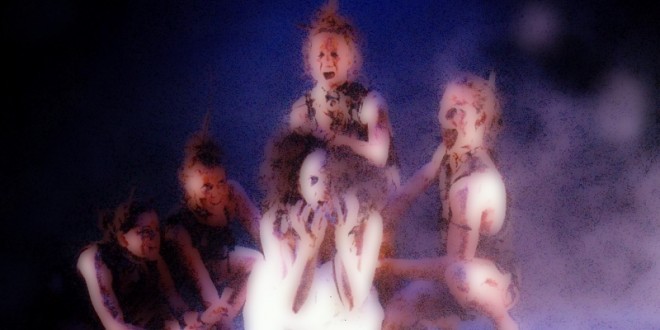Dear Reader
Although I had done theatre before, beginning in 1986 with my own dance production, and several shows and a multi-nation tour with Wildfire World Theatre in the early 1990s, Macbeth was the piece that made me a believer in the power of music and sound in drama. My first collaborative piece with Zen Zen Zo was created long distance, mostly through written communication by fax. I had not met any of the company and had no idea about their style or their personalities. Their communication about what they were doing was very detailed and explicit - although even with this, there were some misunderstandings.
This was some time ago, 1995, before effective email, Skype and internet chat where available in the regional town of Toowoomba. The fax machine was the quickest way to communicate in writing, but the music I wrote was still sent to Kyoto by mail on cassette tapes. They sent me a fax with a section of script and details of the treatment. The production was bilingual, Macbeth himself a well known Japanese actor who spoke no English, Lady Macbeth spoke no Japanese. The witches, the Weird Sisters, had an extended role, voicing the darkest thoughts and suggestions of various characters in both languages. The story was told through the combination of text, dance, mime, sweat, mud. And music.
Instructions from directors Lynne Bradley and Simon Woods would include a diagram of the space and the movement, times to speak lines and monologues, beats and rough tempos for dance sections, and clear instructions about the intention of each character towards each other and the way the audience should be led, both intellectually and emotionally. I wish I had those notes now - it was the most extraordinary analysis of the "Scottish play" with their own rather special take on the relevance of Shakespeare to today's audiences. I knew exactly what I wanted my audience to feel too, and I felt it as I worked on the music.
What I loved about the fax machine was the clarity of expression. Everything was there, I didn't need to interpret what was being said. I guess because I didn't know them, I didn't try to read between the lines, and because they didn't know me, the writers were very careful not to leave anything too open. There were a couple of times I missed it though.
Simon had asked for a piece for the Lady Macbeth monologue "out damned spot". He indicated that the famous lines would be interspersed with particular movement. He needed a piece with music, then silence "so we can hear the text". So I gave them a piece with gaps, and sent in by mail. A week later I received a fax. "Thanks for Lady M. We like it but we cut the text." From this I assumed that they had decided to simply leave that scene out.
When I finally got to Kyoto and saw how my music was affecting the cast, I had found myself a new obsession. The "spot" scene was still in, but the text was gone. Lady Macbeth suffered her madness in the silences. The music did its job, and the audience suffered with her.
Related Posts
- Terror: The Terror is a piece that was originally written for Zen Zen Zo to express the horror of the 1995 Kobe earthquake.
- Eye Contact: On some occasions an unexpected emotional connection occurs, and can be overwhelming.
- Spinning: The "spin" is a exercise in physical theatre rather like the whirling of the Dervish.
- Current practice: I am now teaching music and sound production full time at Tertiary level and continue to work compose for collaborative projects.
- Selected Musical Projects: A selected listing of recorded works and collaborative projects.
- Anxiety Attacks: Nasty, painful, frightening but not fatal.
- Speaking, Hearing, Seeing: People with Asperger's and HFA often have unusual ways of speaking, hearing and seeing interpersonal communication modes.
